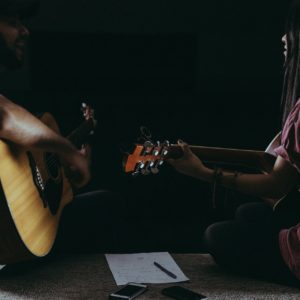by Metro Music Makers instructor Mark Grundhoefer
I was working on songwriting with one of my students and a question came up that I get asked all the time: “How do you write music without words?”
My half-joking response is usually, “How do YOU write music WITH words?!”
 Besides my job as a teacher, I make a living writing and playing instrumental music in classical, jazz and rock genres and publishing them on iTunes, Spotify, etc. I’ve never felt comfortable or inspired to write lyrics. And honestly, I haven’t tried since my high school band.
Besides my job as a teacher, I make a living writing and playing instrumental music in classical, jazz and rock genres and publishing them on iTunes, Spotify, etc. I’ve never felt comfortable or inspired to write lyrics. And honestly, I haven’t tried since my high school band.
The process for writing an instrumental piece is not that different from the typical song. You still have the elements of melody, accompaniment and rhythm. The main difference (obviously) is that no vocals are used for the melody, so an instrument takes the role. There are also plenty of instrumental artists and composers that write ambient or drone-style minimalist compositions that seem to lack a lot of melodic components, but for the purpose of this blog, we’ll focus on the melodic style.
Here are a few simple ideas to get you started:
- Start with the melody. Ironically, I tend to start by singing or humming. Then I grab my guitar — or piano or whatever instrument I want to write with — and play the melody. A guitar has a unique ability to sound like a voice with the use of slides, bends, vibrato and other extended techniques, which is why I tend to gravitate towards that as my lead instrument.
- Once you have a melody, build some chords around it. If you’re composing for the piano, try playing the melody with your right hand and doing a few chords with the left. If you’re a guitarist, use some open strings or fretted notes in the bass to add harmonic content under the melody. Of course, your accompaniment could be a riff or pattern that works in counterpoint to your melody, but start with baby steps and work your way up. If you don’t know a lot of the musical theory required to put chords to melody, ask your Metro Music Makers teacher for help!
- If you have a band or are planning on working in a recording program like GarageBand/Logic, you’ll have the ability to add many instruments to your piece. Write or program a drum beat, add some strings or horns, and play with sound effects.
- It’s also important to physically write down your ideas. There is a plethora of software that helps you notate music (there are even iOS apps), and you should take advantage of it so you can share it with other musicians. A few nights ago, I wrote a new solo guitar piece, and before I recorded it, I transcribed it on staff paper. Now I won’t forget it and can focus on practicing it so the recording and performances go smoother.
Music has to tell a story. It’s pretty obvious how to do that with lyrics. But when no words are used in a song, can it still tell a story or express a mood? Of course!
I’ll leave you with these two songs. One of my favorite artists is Ben Folds. He’s a fantastic lyricist, but also an incredible arranger and performer. The first part of the song is instrumental. Notice the melody and accompaniment, and then think about what story it might tell. Then, listen to the second part where he sings some very descriptive lyrics. You’ll be surprised at how similarly emotive the instrumental piece can be.
Before Cologne: https://youtu.be/Cx8bSFlhN5M
Cologne: https://youtu.be/WEhIFbd7WK4
